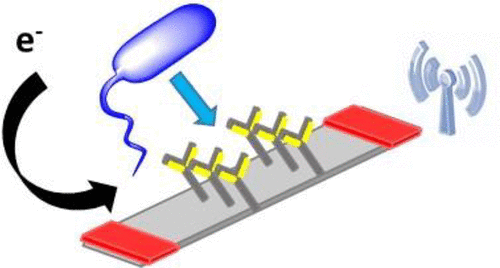Our official English website, www.x-mol.net, welcomes your
feedback! (Note: you will need to create a separate account there.)
Electrochemical Methodologies for the Detection of Pathogens
ACS Sensors ( IF 8.2 ) Pub Date : 2018-05-14 00:00:00 , DOI: 10.1021/acssensors.8b00239 Mandana Amiri 1 , Abolfazl Bezaatpour 1 , Hamed Jafari 1 , Rabah Boukherroub 2 , Sabine Szunerits 2
ACS Sensors ( IF 8.2 ) Pub Date : 2018-05-14 00:00:00 , DOI: 10.1021/acssensors.8b00239 Mandana Amiri 1 , Abolfazl Bezaatpour 1 , Hamed Jafari 1 , Rabah Boukherroub 2 , Sabine Szunerits 2
Affiliation

|
Bacterial infections remain one of the principal causes of morbidity and mortality worldwide. The number of deaths due to infections is declining every year by only 1% with a forecast of 13 million deaths in 2050. Among the 1400 recognized human pathogens, the majority of infectious diseases is caused by just a few, about 20 pathogens only. While the development of vaccinations and novel antibacterial drugs and treatments are at the forefront of research, and strongly financially supported by policy makers, another manner to limit and control infectious outbreaks is targeting the development and implementation of early warning systems, which indicate qualitatively and quantitatively the presence of a pathogen. As toxin contaminated food and drink are a potential threat to human health and consequently have a significant socioeconomic impact worldwide, the detection of pathogenic bacteria remains not only a big scientific challenge but also a practical problem of enormous significance. Numerous analytical methods, including conventional culturing and staining techniques as well as molecular methods based on polymerase chain reaction amplification and immunological assays, have emerged over the years and are used to identify and quantify pathogenic agents. While being highly sensitive in most cases, these approaches are highly time, labor, and cost consuming, requiring trained personnel to perform the frequently complex assays. A great challenge in this field is therefore to develop rapid, sensitive, specific, and if possible miniaturized devices to validate the presence of pathogens in cost and time efficient manners. Electrochemical sensors are well accepted powerful tools for the detection of disease-related biomarkers and environmental and organic hazards. They have also found widespread interest in the last years for the detection of waterborne and foodborne pathogens due to their label free character and high sensitivity. This Review is focused on the current electrochemical-based microorganism recognition approaches and putting them into context of other sensing devices for pathogens such as culturing the microorganism on agar plates and the polymer chain reaction (PCR) method, able to identify the DNA of the microorganism. Recent breakthroughs will be highlighted, including the utilization of microfluidic devices and immunomagnetic separation for multiple pathogen analysis in a single device. We will conclude with some perspectives and outlooks to better understand shortcomings. Indeed, there is currently no adequate solution that allows the selective and sensitive binding to a specific microorganism, that is fast in detection and screening, cheap to implement, and able to be conceptualized for a wide range of biologically relevant targets.
中文翻译:

病原体检测的电化学方法
细菌感染仍然是全世界发病率和死亡率的主要原因之一。每年由于感染引起的死亡人数仅下降1%,预计到2050年将有1300万人死亡。在1400种公认的人类病原体中,大多数传染病仅由少数几种引起,仅约20种病原体。尽管疫苗和新型抗菌药物及治疗方法的开发处于研究的前沿,并得到了政策制定者的大力支持,但限制和控制传染病暴发的另一种方式是针对预警系统的开发和实施,该系统从数量和质量上进行了说明。病原体的存在。由于毒素污染的食品和饮料对人类健康构成潜在威胁,因此在全世界范围内都具有重大的社会经济影响,致病细菌的检测不仅仍然是一项重大的科学挑战,而且是具有重大意义的实际问题。多年来,已经出现了许多分析方法,包括常规的培养和染色技术以及基于聚合酶链反应扩增和免疫分析的分子方法,这些方法被用于鉴定和定量病原体。尽管这些方法在大多数情况下非常敏感,但它们既耗时,费力又费钱,需要受过训练的人员来执行频繁的复杂测定。因此,该领域面临的一大挑战是发展快速,敏感,特定,如果可能的话,还可以使用小型设备以成本和时间高效的方式验证病原体的存在。电化学传感器是公认的功能强大的工具,可用于检测与疾病相关的生物标记以及环境和有机危害。由于它们的无标记特性和高灵敏度,最近几年,他们还发现了检测水和食源性病原体的广泛兴趣。这篇综述着重于当前基于电化学的微生物识别方法,并将其置于其他病原体传感设备的背景下,例如在琼脂平板上培养微生物和能够识别微生物DNA的聚合物链反应(PCR)方法。 。最近的突破将被重点介绍,包括利用微流体设备和免疫磁分离技术在单个设备中进行多种病原体分析。我们将以一些观点和前景作为总结,以更好地理解缺点。实际上,当前没有足够的解决方案允许对特定微生物的选择性和敏感结合,其检测和筛选快速,实施便宜且能够针对广泛的生物学相关靶标进行概念化。
更新日期:2018-05-14
中文翻译:

病原体检测的电化学方法
细菌感染仍然是全世界发病率和死亡率的主要原因之一。每年由于感染引起的死亡人数仅下降1%,预计到2050年将有1300万人死亡。在1400种公认的人类病原体中,大多数传染病仅由少数几种引起,仅约20种病原体。尽管疫苗和新型抗菌药物及治疗方法的开发处于研究的前沿,并得到了政策制定者的大力支持,但限制和控制传染病暴发的另一种方式是针对预警系统的开发和实施,该系统从数量和质量上进行了说明。病原体的存在。由于毒素污染的食品和饮料对人类健康构成潜在威胁,因此在全世界范围内都具有重大的社会经济影响,致病细菌的检测不仅仍然是一项重大的科学挑战,而且是具有重大意义的实际问题。多年来,已经出现了许多分析方法,包括常规的培养和染色技术以及基于聚合酶链反应扩增和免疫分析的分子方法,这些方法被用于鉴定和定量病原体。尽管这些方法在大多数情况下非常敏感,但它们既耗时,费力又费钱,需要受过训练的人员来执行频繁的复杂测定。因此,该领域面临的一大挑战是发展快速,敏感,特定,如果可能的话,还可以使用小型设备以成本和时间高效的方式验证病原体的存在。电化学传感器是公认的功能强大的工具,可用于检测与疾病相关的生物标记以及环境和有机危害。由于它们的无标记特性和高灵敏度,最近几年,他们还发现了检测水和食源性病原体的广泛兴趣。这篇综述着重于当前基于电化学的微生物识别方法,并将其置于其他病原体传感设备的背景下,例如在琼脂平板上培养微生物和能够识别微生物DNA的聚合物链反应(PCR)方法。 。最近的突破将被重点介绍,包括利用微流体设备和免疫磁分离技术在单个设备中进行多种病原体分析。我们将以一些观点和前景作为总结,以更好地理解缺点。实际上,当前没有足够的解决方案允许对特定微生物的选择性和敏感结合,其检测和筛选快速,实施便宜且能够针对广泛的生物学相关靶标进行概念化。











































 京公网安备 11010802027423号
京公网安备 11010802027423号